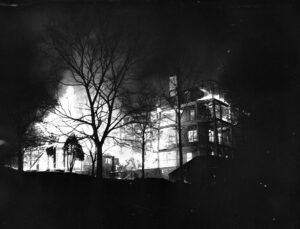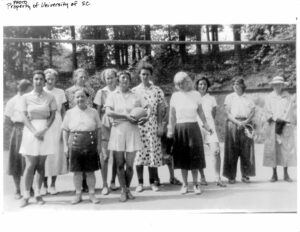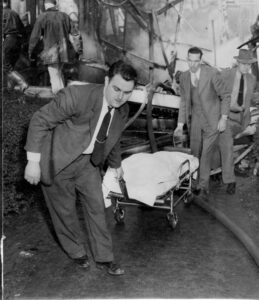
Inside the 1948 fire that killed Zelda Fitzgerald
On March 9, 1948, Zelda wrote to her daughter, “there is promise of spring in the air and an aura of sunshine over the mountains; the mountains seem to hold more weather than elsewhere and time and retrospect flood roseate down the long hillsides.”


“There are six places in Oak Lodge (one of the Highland Hospital patient buildings) I have picked out that could be set (on) fire. I have thought about it so much, I am afraid of what I might do and I want you to lock me up.” Willie Mae Hall, night supervisor at the Asheville mental institution, told police in hysterics on the evening of April 12, 1948, just over a month after a fire at the hospital killed nine patients, including author and artist Zelda Sayre Fitzgerald, who at the time was best known as the widow of author F. Scott Fitzgerald.
The police questioned Willie Mae, a single, “middle-aged, stocky (woman with) straight hair and a plain face,” for the next six hours. When asked whether she set fire to the hospital’s Central Building, Willie Mae replied, “I don’t know. I really don’t know. I don’t believe I did, but I could have.”
Officers secured her in the county jail and reopened the investigation into the deadly fire. Just weeks earlier a coroner’s jury had “absolved the hospital and attendants of culpable blame,” but now it seemed that perhaps a crime had been committed.
Wednesday, March 10, 1948 had been a fairly unremarkable day at Highland Hospital. It was the final hour of the night that would make history.
In Central Building, the night nurses – Doris Anderson and Ruth Dunn – came on duty at 10 p.m.
Doris, a registered nurse from Wisconsin, had only been working at the hospital since March 1. She had come to Highland for a postgraduate training position. It was her first night in charge of Central Building, which housed 29 female patients. Willie Mae, who was supervising all the patient buildings that night, walked Doris through the night procedures and fire rules.
After her orientation, Doris made a round of the hospital. As part of her duties, she administered a strong sedative and hypnotic to her patients, including Zelda Fitzgerald.
Zelda had been diagnosed as a chronic schizophrenic – though modern psychiatrists believe she may have suffered from bipolar disorder. She had been in and out of Highland Hospital since her husband, Scott, checked her in on April 8, 1936.
Scott, now a decade out from publishing “The Great Gatsby,” had sequestered himself in the nearby Grove Park Inn attempting to write and recuperate from tuberculosis, but spent most of his time in a drunken haze, even confessing to one of Zelda’s doctors that “perhaps 50 percent of our friends and relatives would tell you in all honest conviction that my drinking drove Zelda insane – the other half would assure you that her insanity drove me to drink…. Neither judgment would mean anything.”
Zelda stayed at Highland for four years until April 1940 when she was released and went home to her parents’ house in Montgomery, Alabama. At the same time, Scott moved to Hollywood, where he quickly met and fell in love with another woman. Before the end of the year he had passed away from a massive heart attack. He was 44 years old.
Five days after his death, Zelda wrote of her late husband, “In retrospect it seems as if he was always planning happiness … books to read, places to go. Life seemed so promissory always when he was around, and I always believed that he could take care of everything. Although we were not close anymore, Scott was the best friend a person could have been to me.”
Zelda checked back into Highland Hospital in August 1943, stayed for six months, checked out in February 1944, and was back by early 1946. She left again to spend a few months with her daughter and new grandson in New York and arrived back at Highland for what would be her final stay on November 2, 1947.
While at Highland, Zelda’s treatment plan included insulin shock therapy. She was daily injected with enough insulin to induce an hour-long coma, often accompanied by a seizure. This was thought by psychiatrists at the time to be therapeutic for those suffering from schizophrenia.
Zelda would occasionally travel to Saluda to visit her mother at the Sayre family’s favorite hotel, the Esseola. The owner’s daughter, Edna Garlington Spratt, remembered of Zelda, “She was anything but pretty when I saw her. She acted normal, but she looked so dreadful. Her hair was stringy and she had lost all pride in herself.”
Despite her outward appearance, Edna recalled that Zelda, “talked a lot about writing and dancing, about her life in Paris. … (She and her mother) made a lot of friends and took long walks. … (She) collected wildflowers. She was crazy about wildflowers.”
At the beginning of March 1948, doctors at Highland Hospital told Zelda she was well enough to be discharged, but Zelda decided to stay on for a few more weeks just to make sure she was ready.
On March 9, Zelda wrote to her daughter, “there is promise of spring in the air and an aura of sunshine over the mountains; the mountains seem to hold more weather than elsewhere and time and retrospect flood roseate down the long hillsides.”
The following night, while Zelda was sedated on the fifth floor of Highland Hospital’s Central Building, smoke began wafting up through the building’s dumbwaiter.
It was 11:30 p.m. Willie Mae had left 10 minutes earlier to check charts in the men’s quarters, Oak Lodge. Doris, the first employee to smell the smoke, began searching for evidence of fire and sent her co-worker, Ruth, up to the fifth floor. When Doris found no flames on the fourth floor, she proceeded down to the third.
At about 11:35 p.m., Doris entered the third floor diet kitchen, which Ruth had just checked during her 11 p.m. rounds. Here, Doris discovered the source of the smoke. The table near the dumbwaiter shaft was on fire around the edges. The flames rose about a foot in the air. According to Doris, the table looked like “one of those fiery hoops animals jump through in circuses.” Another table, containing a hot plate and electric kettle was unscathed.
Doris hesitated, unsure of what to do, then rushed out of the kitchen. As the door shut behind her, she hesitated again and turned to peek back at the fire. Yet, she did not attempt to put it out. Instead she ran to her station on the fourth floor and called Oak Lodge as Willie Mae had instructed her to do in the event of an emergency. She got the central telephone exchange operator, who tried to connect her to the lodge, but got a busy signal. Doris then asked the operator to connect her to the fire department. They answered right away.
With the alarm raised, Doris tried again to notify others at Highland Hospital. The operator connected her to Highland Hall; she told the person who answered to call Oak Lodge and notify Dr. Basil T. Bennett, the hospital’s medical director.
While waiting for the firefighters to arrive, Doris and Ruth began arousing and evacuating patients with the help of other employees, neighbors, and passersby who saw the flames and came to help.
Doris ran back up to the fourth floor and unlocked the main door. She also used her key to open one patient’s room door. Other patients’ rooms remained locked. “Only the ‘violent’ ones, or patients incapable of helping themselves, were locked up,” Nurse Bettie Ubbenga, who had joined the rescue effort minutes after the alarm was raised, told reporters.
Bettie continued, “The first thing we did was to go after the helpless ones (those who were locked in) and we felt that the others were awake and would help themselves. I can’t understand why, what with all the shouting, clamor and general rattle around the place, all the others were not awakened. As soon as we got the helpless ones out and safely put away elsewhere, we rushed back to help the others. By then, we knew that some had been trapped. … The smoke must have rendered some of them unable to assist themselves. They must have become unconscious before becoming fully awakened, is the only way I can explain it.”
After leading four patients to safety, Doris climbed to the fifth floor, where Zelda Fitzgerald and 10 other women resided. Before she could wake any of the women, smoke rising through the dumbwaiter overwhelmed her and she fled.
Twenty-five minutes after Doris first smelled smoke, the fire department arrived at Highland Hospital to find flames bursting through the building’s roof. Their efforts to rescue the women were hindered by the building’s screened porches and chain-shackled windows, which were meant to keep patients from jumping to their deaths.
Still, after a long night, with the help of staff and volunteers, firefighters had extinguished the blaze. Two patients died after being rescued. Seven missing patients, who all resided on the fifth floor, including Zelda, were presumed dead.
Reporters swarmed the site, trying to glean as much information about the fire and the dead as possible. Willie Mae said that she had been near the diet kitchen a few minutes before the fire was discovered, but saw “no evidence of it at that time.” She suspected that an electric coffee urn that had been heating in the diet kitchen likely started the fire.
Willie Mae’s story was repeated by others on the scene, including Bettie Ubbenga who said, “I heard it started from an electric coffee urn. It must have been something electric because when we reached the building, sparks and flame were all over the diet kitchen area. The fire traveled so fast. It seemed no time at all until the entire building was like a furnace.”
The next evening, two bodies were pulled from the rubble of the building’s south wing. One was tentatively identified, and later confirmed with dental records, as Zelda Fitzgerald.
Zelda’s remains were transferred to Maryland to be buried in St. Mary’s Church Historic Cemetery beside F. Scott Fitzgerald. Their gravestone read, “So we beat on, boats against the current, borne back ceaselessly into the past;” – the last line of “The Great Gatsby.”
A few days later, Willie Mae testified at the coroner’s inquest of her movements the night of the fire. She mentioned nothing about potentially being the one who set the table aflame until she turned herself into police a month later.
The court ordered her to undergo a psychiatric evaluation with Dr. Wesley Taylor. Dr. Taylor told the judge in charge of Willie Mae’s case that the night before Willie Mae arrived at the police station in April she had dreamed of two patients who had died in the fire. They told her, “Since you have burned us up, now go and burn Oak Lodge as well.”
During the examination, according to Dr. Taylor, Willie Mae also “assumed some other responsibilities in which she had no hand, such as a couple of small fires in the basement or the first floor of the Central Building about 10 months ago.” At least three fires had been noted in Central Building over the past year. All had been extinguished quickly. None had been reported to the fire department. The cause of those fires was unknown.
Dr. Taylor told the court that he did not think Willie Mae was a criminal; instead he theorized that, “we are dealing with an hysterical woman who has been much overworked and worried, and who puts too much emphasis on dreams.”
With this professional opinion in hand, the judge determined that Willie Mae would be committed to Graylyn Mental Hospital in Winston-Salem “for further observation and rest.” She was discharged less than two weeks later after undergoing psychological observation, which included interviews under the influence of pentothal, thought at the time to be a “truth serum.”
During some interviews, she admitted culpability. During others, she said “that she had not done it, although she was still doubtful.” The doctors advised her that leaving the Asheville area would help her heal.
On May 16, 1948, just a little over two months after the fire, Willie Mae wrote to Highland’s medical director, Dr. Bennett, from a Mississippi farm where she was staying with her brother and sister-in-law. She was in a dispute with the couple over the ownership of the home. She admitted to the doctor, “While I was talking to my sister-in-law, the thought flash(ed) through my mind, ‘if that is how much you appreciate the place, I will burn the damn thing down.’”
While Willie Mae skipped over the circumstances of her subsequent arrest, she wrote Dr. Bennett, “I was admitted to the hospital for all this came back like you said it would.” When the hospital inquired of Dr. Bennett about Willie Mae’s medical history, he replied, “Prior to this incident, it was recognized that she had certain minor personality disturbances, consisting of her tick and asocial tendencies… [but she was] one of our most conscientious and reliable nurses.”
Willie Mae closed her letter to Dr. Bennett, “I hope to never forget what you said when I saw you that night, that regardless of whether I did it or not you would do all you could to help me.”
The families of a number of the patients who died in the fire brought civil suits against the hospital and its employees, which were eventually settled out of court. No one was ever charged with a crime.
Anne Chesky Smith is the Executive Director of Asheville Museum of History.
